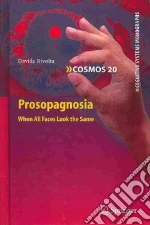 Libri di Davide Rivolta su Unilibro.it) Libri di Davide Rivolta su Unilibro.it)
|
|
2025 |
 Title :
Riconoscere. Come il cervello crea ciò che vediamo (e come può sbagliare)
Title :
Riconoscere. Come il cervello crea ciò che vediamo (e come può sbagliare)Author: Rivolta Davide Publisher: Santelli I volti rappresentano lo stimolo sociale per eccellenza, fondamentali per comprendere emozioni, intenzioni e identità dell'altro. Anche se riconoscere i volti può apparire semplice e immediato, la ricerca scientifica ci dice che le cose non stanno così. Infatti, circa una persona su cinquanta soffre di prosopagnosia, l'incapacità di riconoscere le persone dalla faccia. Nel libro si discutono aspetti psicologici e neuroscientifici del riconoscimento di volti sano e patologico, sia nella direzione dell'incapacità di riconoscere i volti, sia in quella opposta, dei soggetti che non dimenticano mai un volto: i cosiddetti super-riconoscitori. Cosa succede quando una persona è chiamata a riconoscere un colpevole? Come subentra la psicologia della testimonianza in un caso giudiziario? € 19,99
Scontato: € 18,99
|
|
|
1913 |
 Title :
Prosopagnosia
Title :
ProsopagnosiaAuthor: Rivolta Davide Publisher: Springer Verlag This book provides readers with a simplified and comprehensive account of the cognitive and neural bases of face perception in humans. Faces are ubiquitous in our environment and we rely on them during social interactions. The human face processing system allows us to extract information about the identity, gender, age, mood, race, attractiveness and approachability of other people in about a fraction of a second, just by glancing at their faces. By introducing readers to the most relevant research on face recognition, this book seeks to answer the questions: “Why are humans so fast at recognizing faces?”, “Why are humans so efficient at recognizing faces?”, “Do faces represent a particular category for the human visual system?”, What makes face perception in humans so special?, “Can our face recognition system fail”?. This book presents the author’s findings on face perception during his research studies on both normal subjects and subjects with prosopagnosia, a neurological disorder characterized by the inability to recognize faces. The book describes two known forms of prosopagnosia: acquired prosopagnosia, which is the result of a brain lesion, and congenital prosopagnosia, which refers to a lifelong, developmental impairment of face recognition. Written in a comprehensive and accessible style, this book addresses both experts (cognitive scientists, psychologists, neuroscientists and computer scientists) and the general public, and aims at raising awareness for a debilitating face recognition disorder, such as prosopagnosia, which is often ignored or misdiagnosed as autism, with serious consequences for the affected persons and their families. € 112,20
|